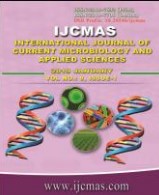


 National Academy of Agricultural Sciences (NAAS)
National Academy of Agricultural Sciences (NAAS)

|
PRINT ISSN : 2319-7692
Online ISSN : 2319-7706 Issues : 12 per year Publisher : Excellent Publishers Email : editorijcmas@gmail.com / submit@ijcmas.com Editor-in-chief: Dr.M.Prakash Index Copernicus ICV 2018: 95.39 NAAS RATING 2020: 5.38 |
Community acquired pneumonia is an infection of pulmonary parenchyma. Despite of advancements in antimicrobial therapy, it stills remains a major threat with significant mortality and morbidity. It accounts for about 13-18% of all nosocomial infections. To identify microbial etiology of cases of Community acquired pneumonia, perform antibiotic susceptibility of the isolates & compare the anti-microbial resistance pattern with special reference to Streptococcus pneumoniae. The study was carried out at SRM Medical College Hospital & Research Centre from February 2012 to February 2013. A total of 619 cases with Community acquired pneumonia were included in the study. Sputum from the clinically proven subjects was collected and processed using standard microbiological techniques. Among the 619 clinical samples, a predominant number (n=224) grew Streptococcus pneumoniae which accounts for 37% of the total isolates followed by Klebsiella pneumoniae (7%, n= 44), Moraxella (4%, n=29), Pseudomonas (4%, n=25), Acinetobacter (2%, n=13), Staphylococcus aureus (2%, n=12) and Non-fermenting Gram negative bacilli (1%, n=6) respectively. 40 % (n=247) of the samples grew normal flora while 3% (n=19) of the samples were considered insignificant since sputum Gram stain findings and culture results were discordant. The causative agent, Streptococcus pneumoniae historically was susceptible to penicillin and many other antimicrobial agents. With the background of changing trends in the etiology of Community acquired pneumonia and also with reference to the antimicrobial therapy this study proves that along with penicillin, resistance has emerged to other agents including Cotrimoxazole and macrolides.
 |
 |
 |
 |
 |